Batteriser is a $2.50 gadget that extends disposable battery life by 800 percent
Bob Roohparvar tells a killer story of industrial espionage. He says the robbery occurred last October at his Batteroo office space in a sprawling Silicon Valley office park. The target was intellectual property surrounding Batteriser, a simple metal sleeve that promises to give consumers up to eight times more life from their disposable batteries, AAA through D.
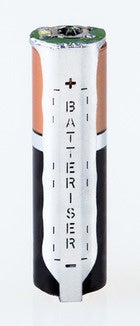 batteroo
batterooThe crooks clearly knew the building layout, and exactly what they were looking for—namely, a breakthrough technology that, if legit, could blow the lid off an alkaline battery industry that's worth $3.4 billion annually in the US alone.
"It was a very, very professional job," says Roohparvar. "They passed by all the offices with open doors, and then banged the hell out of my door, breaking it in. The doorknob was slammed so hard into the wall, it got stuck in the plaster. They took my hard disk and a bunch of USB drives. They took our Batteriser samples. They knew exactly how much time they had before the police would respond."
Roohparvar, who has a Ph.D. in electrical engineering and a long career in power management including a VP stint at Broadcom and a CEO stint at FlexPower, says he's not worried about the theft, because Batteriser has full patent protection. But once the battery manufacturers grasp what Batteriser can do—assuming it works as advertised—they might be worried by this simple gadget, which will cost just $10 for a pack of four when it goes on sale in September.
How Batteriser gives your batteries 8 new lives
A completely new alkaline battery is rated to generate 1.5 volts, but once its output drops below 1.35 or even 1.4 volts, it effectively becomes useless to many devices. The battery's chemical cocktail is still loaded with juice, but the circuitry in many gadgets (especially more sophisticated ones, like Bluetooth keyboards and bathroom scales) considers the battery dead.
This is where Batteriser comes in. It's essentially a voltage booster that sucks every last drop of useable energy from ostensibly spent batteries. So, instead of using just 20 percent of all the power hidden inside of your Duracells and Energizers, Batteriser makes effective use of the remaining 80 percent.
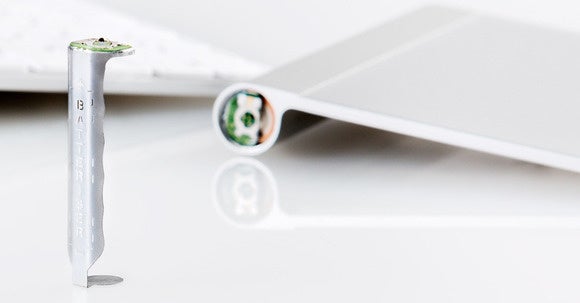 Batteroo
Batteroo Batteriser is thin enough to fit inside a Bluetooth trackpad, just like this one.
Voltage boosters are nothing new, but Batteriser scales down the technology to the point where it can fit inside a stainless steel sleeve less than 0.1 mm thick. Roohparvar says the sleeves are thin enough to fit inside almost every battery compartment imaginable, and the combined package can extend battery life between 4.9x for devices like remote controls and 9.1x for various electronic toys.
"The Batteriser has boost circuitry that will boost the voltage from 0.6 volts to 1.5 volts and will maintain voltage at 1.5—which is a brand new battery," Roohparvar says. "There's actually no IP [intellectual property] in the boost circuitry. Our technology is really a miniaturization technique that allows us to build the sleeve. We have some IP in some of the IC circuits that are in there, but the key is we've been able to miniaturize the boost circuit to a point that no one else has been able to achieve. "
Proving Batteriser actually works
To prove that he's not peddling snake oil, Roohparvar gave me a demonstration of Batteriser's effectiveness.
First he ran tests on two "dead" AA batteries with a power meter. The batteries read 1.3 volts each. He then put the batteries inside a Bluetooth keyboard and connected the keyboard to a Mac. An onscreen display reported the batteries were toast. Such is the heartbreak of old-school battery tech. It's been this way since 1947.
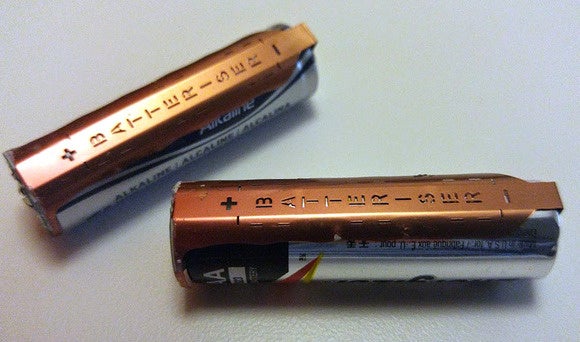 Jon Phillips
Jon Phillips The Batteriser surely wouldn't survive deliberate abuse, but I found it felt much more strong than it looks.
Next he slipped the batteries inside two Batteriser sleeves. He ran the metering test again. The same ostensibly dead batteries read 1.5 volts. He then slipped the batteries—now ensconced in Batteriser jackets—into the keyboard. Voila: The Mac reported the battery level at 100 percent.
Shocking? It shouldn't be. Again, the basic concepts behind the voltage boost have been employed for years. Batteroo has simply scaled down the requisite hardware to a practical formfactor.
The Batteriser looks fragile, but the sleeve is surprisingly sturdy to the touch. It would never survive deliberate abuse, but it doesn't feel like wispy metal foil in the least. Batteroo says compatibility testing shows Batteriser works with a wide variety of gadgets including wireless keyboards, game console controllers, TV remotes, digital scales, blood pressure monitors, toys, and (of course) the ubiquitous flashlight.
Granted, simple devices like flashlights will continue to work with alkaline batteries that dip well below 1.4 volts. They'll just lag and sputter—consider that incredibly dim flashlight that's on its last breath. But Batteriser promises to keep these devices "topped off," if you will. Roohparvar says the sleeve will also work with 1.2 volt rechargeable batteries, boosting them up to 1.5 volts.
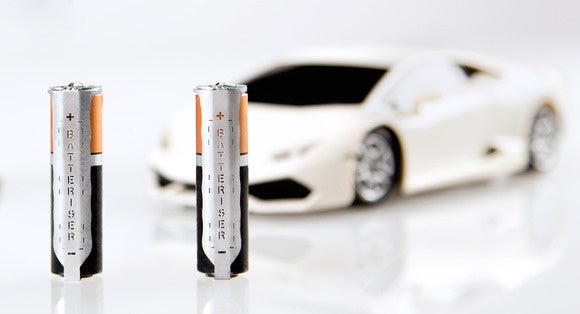 Batteroo
Batteroo Batteroo says toy cars are a perfect application for extending battery life.
The Sunnyvale-based company has also verified its technology with the physics department of San Jose State University. "We tested the Batteriser sleeve in our lab and we confirmed that the Batteriser taps into 80 percent of energy that is usually thrown away," said the university's Dr. Kiumars Parvin in a statement.
Squeezing energy from the bottom
To explain how Batteriser works, Roohparvar uses a toothpaste tube analogy: If you buy a new tube of toothpaste and only squeeze from the very top, you'll extract just a small portion of the paste in the tube. However, if you squeeze from the bottom and keep pushing upward, you'll extract much more of the toothpaste—or in Batteriser's case, energy—that you paid for.
It's important to note that while "dead" batteries typically have 80 percent of their energy remaining inside, Batteriser doesn't suck these cells completely dry. So how, exactly, does Batteriser increase battery life by a factor of eight? Let's do the math.
Let's say you buy a new battery. You use it for a month and its voltage drops to 1.4. It's now ostensibly dead at 1.4 volts, but if you slip on a Batteriser, its output increases to 1.5 volts for another month. That's already a 2x increase in battery life.
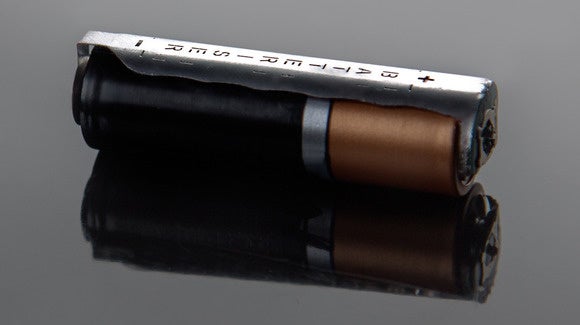 Batteroo
BatterooEventually the battery's natural, unboosted output drops to 1.3 volts—but Batteriser keeps it at 1.5 volts for another month. Now you've realized a 3x increase in battery life. And so on, and so on. Roohparvar says Batteriser can continue to deliver a 1.5 volt charge in batteries that have discharged down to 0.6 volts. There are more than eight 0.1 volt steps between 0.6 and 1.5 volts, so, in grossly simplified terms, the Batteriser can extend operational battery life somewhere around a factor of eight.
And here's an interesting tidbit in Batteroo's patent: Voltage drops aren't linear, and this plays to the consumer's advantage:
"The time it takes for the battery voltage to drop by 0.1V is longer at lower voltages versus at higher voltages. That means that if a constant current was drawn from the battery, it would take the battery a lot longer to discharge from 1.2V to 1.1V than it would from 1.5V to 1.4V. This means that the extent to which the battery life is increased could be even higher."
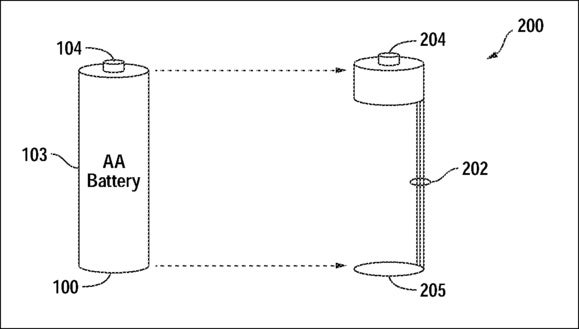
It's always nice to see a patent drawing that bears a passing resemblance to the final product. The patent number is US 20120121943 A1, and was published in May 2012.
The company says Batteriser has an unlimited shelf life, and can be used again and again assuming the sleeves aren't damaged. Oh, and in case you were wondering (I was): Batteroo says the sleeve and its boost circuitry doesn't introduce any extra risk of chemical leakage.
Reducing costs and saving the planet
Disposable alkaline batteries aren't glamorous. They'll never out-sexy the Apple Watch or Surface Pro 3. But they've become staples of modern life, and if there's anything that presents recurring costs ad infinitum, it's a household staple. To this extent, the Batteriser has the potential to not just disrupt but practically detonate an industry that has a stranglehold on so many household appliances.
Count the number of active alkaline batteries in your home. I counted 17 cells across two TV remotes, an Xbox controller, a Withings WiFi scale, a Simplehuman automatic trashcan, and a Remington hair trimmer. Now consider what it would mean to replace these batteries eight times less frequently. The cost and convenience dividends add up.
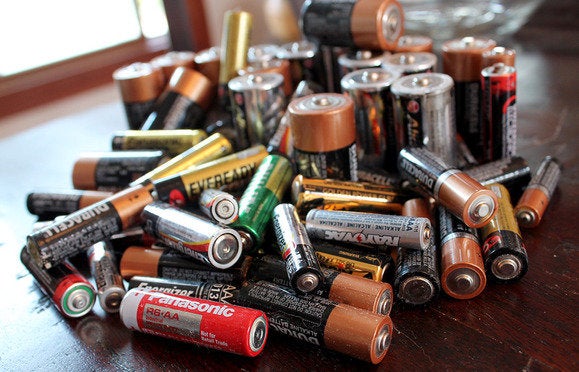 Jon Phillips
Jon Phillips This is my collection of spent alkaline batteries. Maybe it's a good thing I never recycled them—with Batteriser I may never need to buy another battery again (barring leaks, of course).
To wit: A four-pack of Duracell AAs costs $4 on Amazon. Slip those AAs into a $10 set of Batterisers, and the circuit boosters will pay for themselves after three typical battery life cycles. Then, after that, you'll theoretically get another five cycles of free battery life. And after that, the batteries themselves will be dead, but the Batterisers will live on to boost the lives of new batteries.
Clearly, the cost savings are significant, but Roohparvar is also quick to remind us that batteries are an environmental disaster that Batteriser can help mitigate. His company says only 2 percent of spent batteries are properly recycled, and the rest are thrown away, leading to soil contamination. "15 billion batteries go into landfill every year," he says, "so we can help avoid that."
Big Battery doesn't understand electronics
Nick Cunningham, a battery market analyst with the Freedonia Group, told me that as "high-drain" devices use more and more rechargeable lithium batteries, the use of alkaline batteries will slow over time. Nonetheless, he estimates the US alkaline battery market was worth $3.4 billion in 2014, and that was up from $3.3 billion in 2012.
Clearly, we Americans are buying a lot of disposable batteries, and while our thirst will diminish, we're not giving them up anytime soon. So why, then, hasn't Big Battery come up with technology like Batteriser on its own? Are Procter & Gamble (owner of Duracell) and Energizer Holdings (the bunny people) outright dumb or simply greedy? Roohparvar says Big Battery has been looking in the wrong direction.
"The battery manufacturers have been focusing on the chemical characteristics of the battery rather than looking at it from an electrical engineering point of view," Roohparvar says. "I asked the ex-CTO of Energizer, 'How come nobody thought about this?' He said, 'Because we're chemical engineers, and we weren't thinking about power management.'"
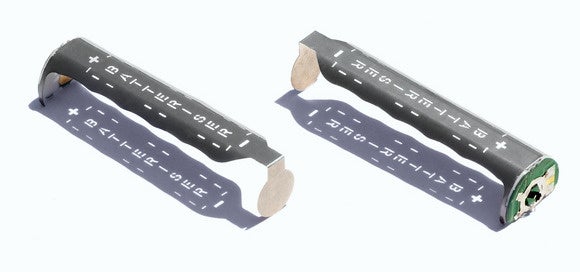 Batteroo
Batteroo Using power management instead of chemistry, Batteriser hopes to have a solution that Big Battery couldn't think up.
I didn't share Batteriser details with Cunningham of the Freedonia Group, but I did ask him if battery manufacturers are working on any solutions that do for standard batteries what CFLs did for light bulbs. His answer: "I don't think so."
"Battery companies understand that alkaline batteries are not going to be used for items such as tablet computers and laptops, but are still trying to improve the performance of alkaline batteries to make them attractive in applications such as portable electronics, flashlights, and clocks," Cunningham said. He cited Duracell's Quantum, which claims to be the longest-lasting alkaline battery of all, and includes an on-board power check meter.
You can keep your money
Roohparvar doesn't rule out bundling Batteriser with alkaline battery packs from Duracell, Energizer and the like, but he's already resisted influence from the battery industry: A VC firm rich with cash from one of the big battery companies was interested in investing, but Batteroo shut the door when it discovered the money trail.
"We want to make sure this technology will stay around for people to enjoy it," Roohparvar says, "and not have someone else own 33 percent of the company and try to dictate how we run the business."
So, for now, the Batteriser is an independent effort. The next step is an Indiegogo campaign in late June, and then delivery in late September.
Only independent testing will prove out all of Batteriser's claims. For instance: Will it work in all my gadgets? Will its circuitry survive eight typical battery life cycles and beyond? And, most importantly, will it deliver the extended battery life that Roohparvar claims? Nonetheless, everything we've seen so far looks very promising. Alkaline batteries definitely don't inspire gadget lust, but when's the last time you heard of industrial spies breaking into Google or Apple?
Indeed. Clearly someone thought the Batteriser was hot enough to go to jail for.
Note: The San Jose Police Department confirmed the break-in occurred on October 29, 2014, and provided me with a case number.
Posted by: Kris Murray <krismurray@gmail.com>
| Reply via web post | • | Reply to sender | • | Reply to group | • | Start a New Topic | • | Messages in this topic (1) |